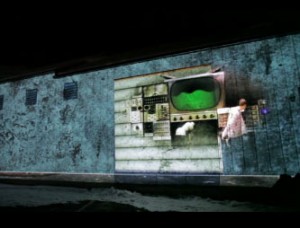Mixing MIT and the Sundance Festival
-
-
slice.mit.edu
Filed Under
Recommended

Is television the "most exciting, most fun cinema"? That's one proposition that arose in a series of articles about the 2013 Sundance New Frontier festival written by MIT Open Documentary Lab researchers last week. They teamed up with Indiewire and the Sundance Institute to cover the festival and the background discussions incubating new ideas.
Initially, says Katie Edgerton, a Comparative Media Studies (CMS) graduate student, people were surprised that an MIT researcher was there, even though many panels focused on the possibilities of new technology.
"Storytelling isn’t the first thing that comes to mind when one thinks about MIT, but the school has a long and often overlooked filmmaking tradition. Cinema vérité pioneer Ricky Leacock was on MIT’s faculty for over a decade. While here, he trained documentarians Robb Moss and Ross McElwee. Leacock’s Film & Video Section was one of several programs that merged to form the MIT Media Lab in 1985. Filmmaker Glorianna Davenport worked closely with Leacock, before founding the Media Lab’s Interactive Cinema division. Her 1989 project "Elastic Charles" let users create a documentary about Boston’s Charles River using an interactive, navigable computer interface."
In fact there was a panel on the Magic of MIT."Assistant Professor Sasha Costanza-Chock of MIT’s Center for Civic Media discussed how technology can enable community-based storytelling, helping people create their own narratives. He profiled SandyStoryline.com, a participatory web documentary about the Hurricane Sandy recovery. Sarah Wolozin, director of the MIT Open Documentary Lab, spoke about digital storytelling projects, while the Media Lab’s Dan Novy—who joined MIT after a long career as a Hollywood visual effects supervisor—showcased some of the MIT technologies under development relevant to filmmaking…"
But back to television at a film festival. Edgerton points out that there are many film-TV crossover points, but screening a television series takes a few adjustments. In one case, "Top of the Lake" was shown as a seven-hour marathon. That wasn't the only unusual screening. An experimental project, a four-channel film titled “North of South, West of East,” was projected onto four sides of a theater and viewers swiveled around in their chairs as the visual story lines unfolded—to one soundtrack that united the action.
Julie Fischer, also a CMS grad student and OpenDocLab research assistant, wrote about "What's He Building in There?" a film about a neighborhood shut-in shown as a massive moving 3D projection on the outside walls of a building.
Interested in the future of film? Read the blogs and learn more about the OpenDocLab, which is taking a fresh look at documentary filmmaking in light of new technologies and participatory potential.
To re-live some of the Sundance Festival, held Jan. 17-27, 2013: cho0se from the 500+ uploaded videos.







